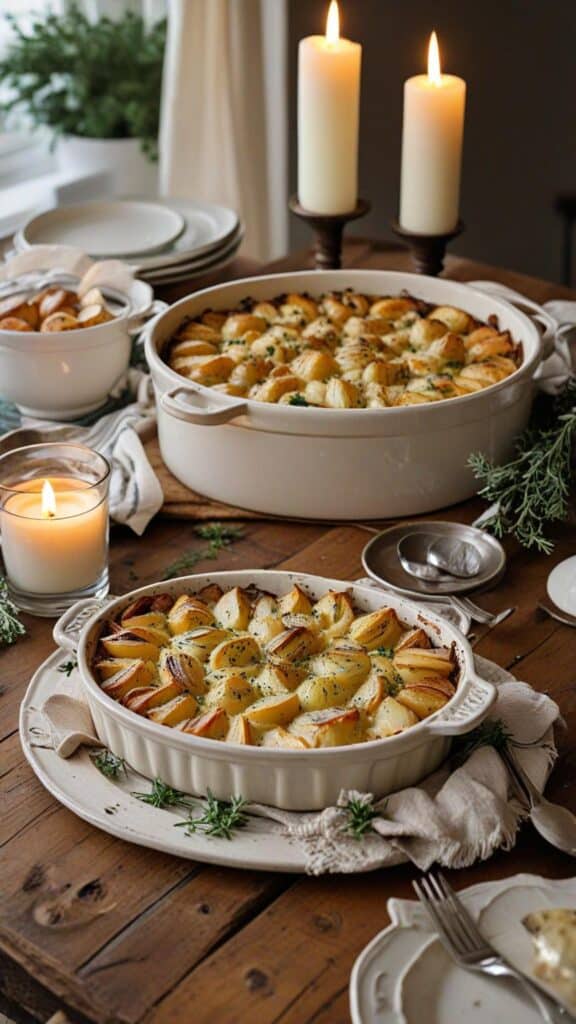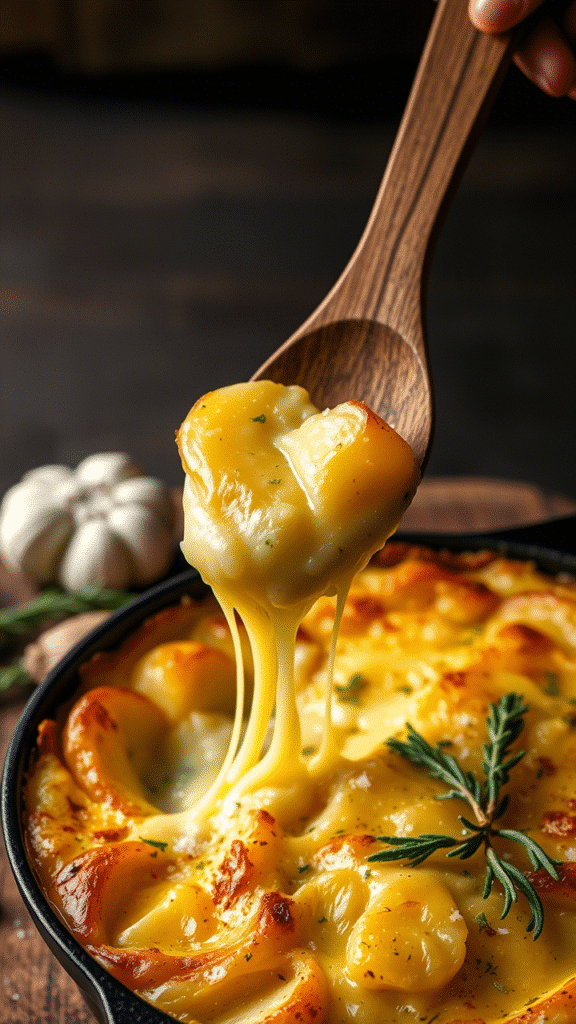Last winter, I found myself standing in my grandmother’s kitchen, holding her tattered recipe card for what she called “funeral potatoes”—though nobody in our family had ever died when she made them. The card was stained with decades of butter and cream, edges soft from handling. What struck me wasn’t just the nostalgia, but how her simple scrawled notes revealed the soul of what we now call potatoes au gratin with roasted garlic.
This dish represents the marriage of French technique with American abundance. It’s comfort food elevated to restaurant quality, where paper-thin potato slices meld with roasted garlic’s sweet complexity and cream’s luxurious embrace. The magic happens in the slow transformation—raw ingredients becoming something that makes grown adults close their eyes and sigh with the first bite.
What sets roasted garlic potatoes au gratin apart from ordinary scalloped potatoes isn’t just the garlic itself. It’s the way roasting transforms those harsh cloves into candy-sweet paste that infuses every layer. The technique creates depth impossible to achieve with raw garlic, adding sophistication without pretension.
Ingredients & Substitutions
The foundation starts with potatoes, and variety matters more than most home cooks realize. Yukon Gold provides the perfect balance—enough starch to create silky layers, sufficient waxy texture to hold structure. Russets work but can become mushy. Red potatoes stay too firm. Trust the Yukons.
For the garlic component, you’ll need two full heads of garlic for roasting. Don’t be tempted to use jarred roasted garlic—it lacks the caramelized sweetness and complex flavor development. Pre-minced garlic from a jar is frankly insulting to this dish.
Heavy cream forms the base liquid, though you can substitute with half-and-half if watching calories. Whole milk works in a pinch but lacks richness. For dairy-free versions, full-fat coconut cream surprisingly works well, though it adds subtle tropical notes that some find distracting.
The cheese selection deserves careful consideration. Gruyère remains the gold standard—its nutty, complex flavor complements roasted garlic beautifully. Swiss cheese works as a more affordable substitute. Sharp cheddar adds tang but can overpower the garlic’s subtlety. For those seeking umami depth, a small amount of aged Parmesan mixed with Gruyère creates exceptional results.
Fresh thyme provides herbal brightness that cuts through richness. Dried thyme works but use half the amount. Rosemary offers a more assertive alternative, though it can dominate. Sage pairs beautifully with both garlic and potatoes but should be used sparingly.
Butter serves dual purposes—enriching the cream mixture and creating golden top browning. European-style butter with higher fat content produces superior results. For those avoiding dairy entirely, high-quality olive oil substitutes adequately, though the flavor profile shifts noticeably.
Step-by-Step Instructions

Preparing the Roasted Garlic
Preheat your oven to 400°F. Cut the top quarter off each garlic head, exposing individual cloves. Drizzle with olive oil and wrap loosely in foil. Roast for 45-60 minutes until cloves feel soft when pressed and smell deeply caramelized.
This step can’t be rushed. Under-roasted garlic retains harshness that will permeate the entire dish. Properly roasted garlic squeezes out like sweet paste, golden and fragrant. Let cool completely before handling—hot garlic burns are particularly unpleasant.
Potato Preparation
While garlic roasts, prep your potatoes. A mandoline slicer ensures uniform thickness, crucial for even cooking. Aim for 1/8-inch slices—thinner becomes mush, thicker stays tough. If using a knife, take time for consistency. Uneven slices mean some pieces finish cooking while others remain raw.
Keep sliced potatoes in cold water to prevent browning, but don’t soak longer than 30 minutes or they’ll lose starch needed for proper binding. Pat completely dry before layering—excess moisture creates a watery final product.
Building the Gratin Base
Squeeze roasted garlic cloves from their skins into a large mixing bowl. Mash with a fork until mostly smooth—a few small lumps add textural interest. Whisk in heavy cream gradually, ensuring no lumps remain. Season generously with salt, white pepper, and fresh thyme leaves.
The cream mixture should taste slightly over-seasoned at this stage. Potatoes will absorb much of the seasoning during cooking, so what seems salty now becomes perfectly balanced later.
Assembly Technique
Butter a 9×13-inch baking dish thoroughly. Layer half the potato slices, overlapping slightly like shingles. Pour half the garlic-cream mixture over, ensuring it reaches between layers. Add half the cheese, then repeat with remaining potatoes, cream mixture, and cheese.
Press down gently with your hands to ensure cream mixture penetrates all layers. The liquid should come about three-quarters up the potatoes’ height—not completely covering, which creates soggy results, but sufficient for proper cooking.
The Cooking Process
Cover tightly with foil and bake at 375°F for 45 minutes. Remove foil and continue baking 30-45 minutes until top is golden and bubbly. A knife inserted in center should meet little resistance—this indicates potatoes are fully tender.
The final browning stage is critical. If the top isn’t achieving proper color, increase oven temperature to 425°F for the last 10 minutes. Watch carefully to prevent burning.
Cooking Techniques & Science
The science behind successful au gratin involves starch gelatinization and protein coagulation. As potatoes cook, their starches absorb liquid and swell, creating the dish’s characteristic creaminess. Simultaneously, proteins in the cream coagulate under heat, binding everything together.

Roasted garlic undergoes the Maillard reaction during its initial roasting phase. This complex chemical process creates hundreds of new flavor compounds, transforming harsh sulfur notes into sweet, nutty complexity. Raw garlic contains allicin, which provides sharpness. Roasting breaks down allicin while developing sugars through caramelization.
The layering technique isn’t merely aesthetic—it ensures even cooking and proper liquid distribution. Each layer should be thin enough for heat penetration while maintaining structural integrity. Overlapping slices create natural channels for cream flow while preventing dry spots.
Temperature control proves crucial throughout the process. Initial covered cooking allows gentle steam penetration, ensuring interior doneness. The final uncovered phase promotes surface browning and moisture evaporation, concentrating flavors and creating textural contrast.
Common Mistakes and Solutions
The most frequent error involves cutting potatoes too thick, resulting in raw centers and overcooked edges. Invest in a quality mandoline or practice knife skills until slices achieve consistency.
Under-seasoning the cream base leads to bland results. Remember that potatoes absorb significant salt during cooking. What tastes properly seasoned in the bowl often becomes insipid in the finished dish.
Using too much liquid creates a soupy mess. The cream should barely cover the potatoes when pressed down. Excess liquid won’t properly reduce during cooking, leaving you with potato soup rather than gratin.
Insufficient roasting of garlic produces harsh flavors that intensify during baking. Properly roasted garlic should be deeply golden and squeeze out like thick paste. Pale, firm cloves need more oven time.
Serving & Pairing Suggestions
This dish shines as a side for roasted meats, particularly beef tenderloin or leg of lamb. The rich, garlicky flavors complement red meat beautifully without competing. For poultry, it pairs excellently with herb-crusted chicken or duck confit.

Vegetarian presentations work wonderfully alongside roasted vegetables or as part of a elaborate brunch spread. The dish’s richness balances bitter greens like arugula or endive salads dressed with sharp vinaigrettes.
Wine pairings should consider the dish’s richness and garlic intensity. Full-bodied whites like Chardonnay or Viognier complement without being overwhelmed. Light reds such as Pinot Noir or Beaujolais provide nice contrast. Avoid tannic reds that clash with the cream base.
For presentation, let the gratin rest 10-15 minutes before serving. This allows layers to set properly for clean portions. Garnish with fresh thyme sprigs or finely chopped chives for color contrast.
Individual ramekin portions create elegant presentations for dinner parties. Reduce cooking time by about 15 minutes and watch carefully to prevent over-browning.
Variations and Creative Twists
Adding thinly sliced leeks between potato layers introduces subtle onion flavor that complements the roasted garlic. Sauté leeks briefly first to remove harsh edges.
Incorporating different cheeses creates unique flavor profiles. A combination of Gruyère and aged cheddar provides complexity, while goat cheese adds tangy richness. Blue cheese works surprisingly well in small amounts, though it’s not for everyone.
For those seeking additional richness, beaten egg yolks mixed into the cream base create custard-like consistency. This technique requires careful temperature control to prevent curdling.
Truffle oil drizzled sparingly over the final dish adds luxury without overwhelming cost. A little goes a long way—start with a few drops and adjust to taste.
Smoked paprika in the cream base provides subtle smokiness that pairs beautifully with roasted garlic’s sweetness. Use sweet paprika for color without heat, or hot paprika for those who enjoy spice.
Conclusion
Roasted garlic potatoes au gratin represents comfort food at its finest—technique-driven yet accessible, elegant enough for special occasions but familiar enough for family dinners. The key lies in respecting each component: properly roasted garlic for sweetness and complexity, uniformly sliced potatoes for even cooking, and well-seasoned cream base for flavor depth.
Success comes from patience rather than complicated techniques. Allow the garlic to roast fully, take time with potato prep, and resist the urge to rush the final browning stage. These small details separate amateur attempts from restaurant-quality results.
The dish rewards make-ahead preparation—assemble completely and refrigerate overnight before baking. This actually improves flavor as ingredients meld together. Add 15-20 minutes to the covered cooking time when baking from cold.
Most importantly, don’t be afraid to make this dish your own. While the basic technique remains constant, small variations in cheese selection, herb choices, or additional ingredients can create signature versions that become family traditions.
Frequently Asked Questions?
Can I make roasted garlic potatoes au gratin ahead of time?
Absolutely. Assemble the entire dish up to 24 hours in advance and refrigerate covered. When ready to bake, add 15-20 minutes to the initial covered cooking time since you’re starting from cold. The flavors actually improve overnight as ingredients meld together. For longer storage, freeze assembled unbaked gratin for up to 3 months, though texture may be slightly different after thawing.
Why are my potatoes still hard after the recommended cooking time?
Several factors can cause this issue. Most commonly, potato slices were cut too thick—they should be uniformly 1/8-inch thick. Old potatoes also take longer to cook than fresh ones. Additionally, insufficient liquid coverage prevents proper steaming during the covered cooking phase. Check that cream mixture comes about 3/4 up the potato layers when gently pressed down.
Can I substitute different types of potatoes?
Yukon Gold potatoes provide the ideal balance of starch and waxy texture for au gratin. Russets become too mushy due to high starch content, while red potatoes stay too firm because of their waxy nature. If you must substitute, try mixing half Russets with half red potatoes to approximate Yukon Gold characteristics. Fingerling potatoes work well but require careful slicing for uniformity.
How do I prevent the top from burning while ensuring the potatoes cook through?
Cover the dish tightly with foil for the first 45 minutes of cooking. This creates steam that cooks potatoes evenly without browning the top prematurely. Remove foil only for the final 30-45 minutes to achieve golden browning. If the top browns too quickly, tent loosely with foil while maintaining some air circulation. An oven thermometer helps ensure accurate temperature—many ovens run hot.
What’s the best way to reheat leftover au gratin?
Cover individual portions with foil and reheat in a 350°F oven for 15-20 minutes until heated through. Microwaving works but can make the texture rubbery. For best results, add a tablespoon of cream or milk before reheating to restore moisture. Leftover gratin also makes excellent hash browns when cubed and pan-fried until crispy—a chef’s secret for using day-old portions.

Veronica is a passionate food enthusiast with over three years of experience in exploring and writing about diverse cuisines. Her expertise lies in reviewing restaurants, sharing creative recipes, and discovering the latest food trends. As the voice behind FoodieRecap.com, Anju brings fresh perspectives and culinary insights to her audience.
